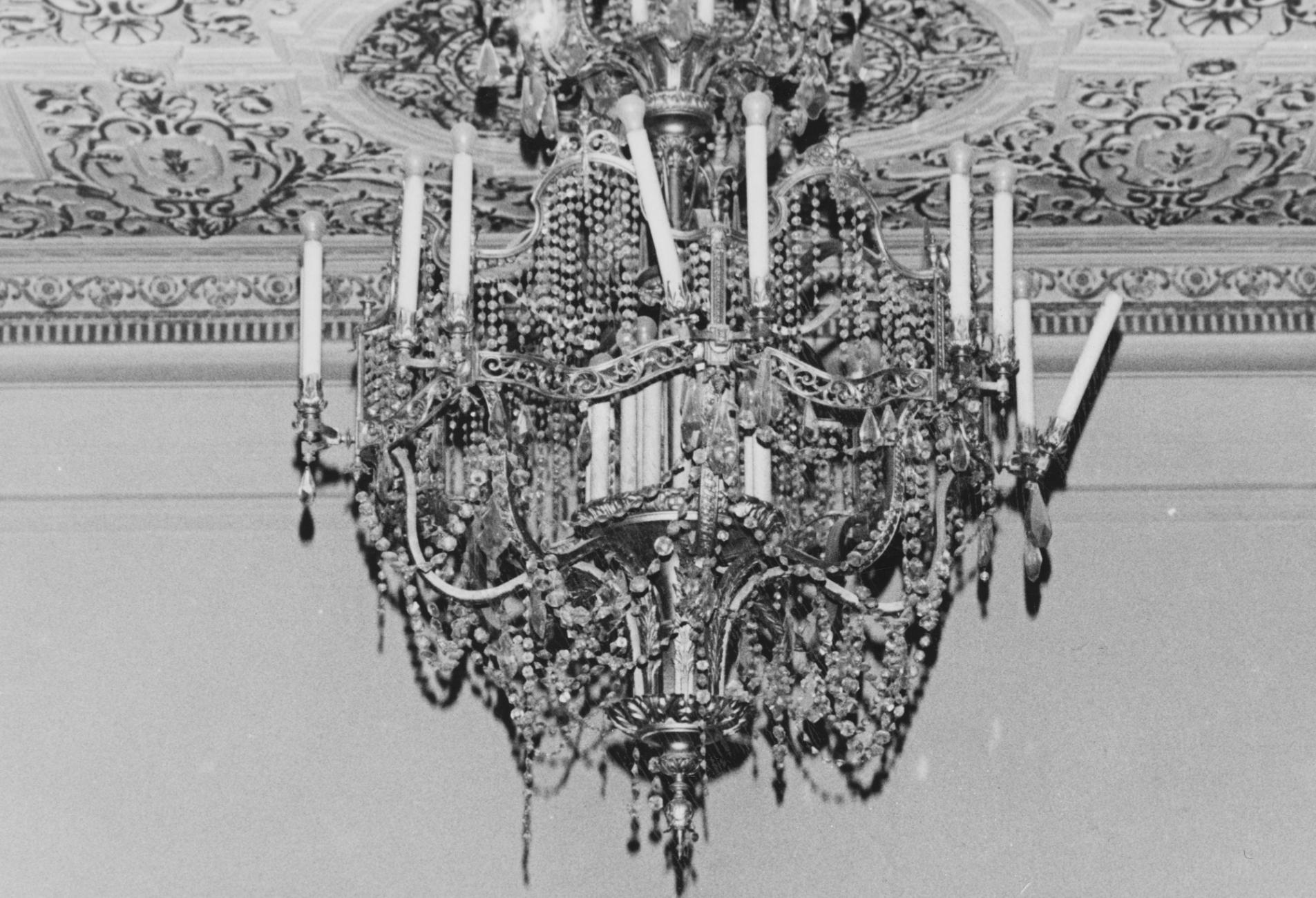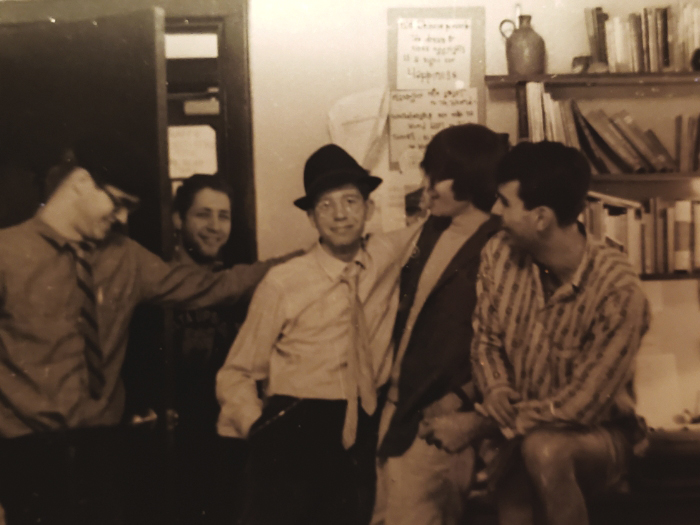
Not many residence halls come with chandeliers, ballrooms, or elderly residents. Shoreland Hall, which closed in 2009, had them all. (Photography by John Hockenberry, EX’85; Copyright 2024, The Chicago Maroon. All rights reserved. Reprinted with permission.)
There are places we’ll remember ...
In the November issue of College Review, the Core’s email newsletter, we asked about defunct residence halls. Readers shared stories of Foster, Boucher, Pierce, the Shoreland—and two tales of long-lasting O-mance sparked at Woodward.—Ed.
Robie
I lived in Foster Hall during 1956–57, the last year it was a full-service dorm. It was the best introduction to college life and a great mix of first-years, upperclasswomen, and graduate students. It was a sad day when the University decided to close it and move those of us who wanted meals to the New Dorms (i.e., Woodward).
Woodward was without character. The only good thing was we had a corner room with a view of Robie House. I had no regrets when Woodward was demolished. Foster is now filled with offices. I wonder whether any of the old character with lovely woodwork is retained.—Betty I. Wolf, SB’60, MD’65
A boy
I entered the U of C in 1961 and moved into New Dorms [later Woodward Court]. We had Orientation, then the upperclassmen arrived. The first day some upperclassmen were sitting and talking in the courtyard. On the other side of the courtyard, I could hear a boy talking. He sounded interesting. I got up and walked around to the other side, by the boy, and two years later we were married.—Nancy Olin Unferth, AB’65, AM’74
Larry
On the first day of Orientation Week, there was a barbecue in the Woodward courtyard for first-years. As I waited in line I saw a group of young men by the fence, gesturing to us to come over. They wanted us to go through the line and get them food. They were second-, third-, and fourth-years, and their meal service didn’t kick in for another week. That is how I met Larry, whom I went on to marry. Still going strong 54 years later.—Ofelia Nunez Svart, EX’71

Norman Maclean
Chauncey Boucher Hall, CB for short [formerly the YMCA’s training college at 53rd and Ingleside], opened as a dorm for the 1966–67 academic year. CB was huge and had a pool, gym, and indoor track. What it did not have was a kitchen. The demographics in year one included undergrads (all classes, with and without meal plans) and grad students. The kitchen problem resulted in some heated exchanges with Residence Halls and Commons.
The great snowstorm in January 1967 started when I was in Professor Norman Maclean’s [PhD’40] Shakespeare class. George Schmidt [AB’69] and I pushed several cars free while walking back to CB.
I can quickly name 15 to 20 dorm mates and see their faces. The nonexistent kitchen contributed to a shared problem and gave us something we worked together to solve.—Jim Lilly, AB’68, AM’69, MBA’80
Sammy Dawg
Pierce Tower was an all-male dorm: pent-up hormones, 2 a.m. water fights in the hallways, firecrackers tossed into—and exploding in—the shower stalls. Around the time of the 1969 sit-in, we elected Sam Dawg to Student Government. Sam Dawg was the unauthorized animal companion of Jeremiah Benn Simmons [EX’69], Tufts resident head.
My favorite memories of Tufts are of its musical soundscape. Some residents had state-of-the-art audio setups, complete with amplifiers, turntables, and tape decks. The popular music of the era wafted through the corridors: the Beatles, the Rolling Stones, Bob Dylan, James Taylor, Gordon Lightfoot, Fotheringay, Judy Collins—and a then-obscure Canadian singer who wrote a lot of the songs in the Judy Collins repertory, Joni Mitchell.
Then there were the classical music buffs. There was Bob Dozor [AB’71], who played these interminable symphonies by an Austrian composer named Mahler; my next-door neighbor Alan Hirsh [AB’72], who once a year played Wagner’s Ring Cycle end to end (overnight); Mark Bednar [AB’72, MBA’76], who didn’t care much for Brahms; and Steven Blau [AB’70, MD’74], who had an encyclopedic knowledge of classical music. Steve liked to jot down his fellow undergraduates’ malapropisms on paper slips, which he pasted on the door to his room. I was one of those so honored.—Zachary M. Baker, AB’72
Fred!
I attended the U of C from 1984 to 1988 and lived on the ninth floor of the Shoreland, Hale House, for all four years.
The storage attic! We were allowed to store our belongings over the summer if we were coming back in the fall. A big musty room with stuff all over the place, no rhyme or reason.
The mice! My sophomore and junior year, I shared a huge apartment with two other women. We had a living room, dining room with chandelier, a full kitchen, walk-in closets, a panoramic view of Lake Shore Drive, and the original furniture from when it was a hotel. There were mice in the drawers of the kitchen. We rarely used it. I did bake potatoes once.
Fred! After a few years, they opened a tiny café called Fred. It served French fries, pizza slices, potato chips, coffee, and this cola called Jolt, for those all-nighters before Red Bull was invented.—Maria Chadam, AB’88
Elvis
I lived in Dudley House on the 12th floor. My first room was apparently one that Elvis stayed in when the Shoreland was a fancy hotel.
I went to the basement to use the pianos and would hear the ska-soul band the Adjusters practicing. I went once to the supposedly haunted 13th floor, but I didn’t see anything other than mice, roaches, and lots of dusty furniture.—Anne Bazile, AB’99
Green I
I lived on the second floor of Green in 1956–57 and on the fifth floor (in the suite at the left end of the hall) from 1957 to 1961, which included my first year of grad school. The first-years’ meals were served there. After New Dorm was built, we had our meals in that dining room with the lovely staircase up to the dining area. I can visualize it to this day.—Helen Gill Sellin, SB’60, PhD’64
Green II
I was a freshman in 1957 and assigned to the New Dorm, a quite awful modernistic building that stuck out like the proverbial sore thumb. I moved the next year to Green, in the middle of campus: old and creaky but warm and charming.
I think the New Dorm got a name along the way, and then I think it might have ceased being a dorm. What happened to it? Meanwhile, does Green—and its fellow dorms, whose names I can’t remember—still exist?—Genie Grohman, EX’61
New Dorm (or Dorms), later named Woodward Court, was demolished in 2002 to make space for the University of Chicago Booth School of Business home, the Charles M. Harper Center.—Ed.
Gates
My first year was in New Dorm, where the business school is today. I have memories of awful meals and dreary, if new, rooms.
I spent my second year as a resident of Foster Hall as a nonboarding student. I began to learn to cook at the U of C. My next two years were in Gates Hall, also as a nonboarding student. I joined with three other students to cook group dinners. That was a pleasant year.
Although I made close friendships at both the New Dorm and Foster, my most pleasant memories of dorm life were the two years in Gates. Dorms were not fun. The friends I made there were precious.—Jo Rita (Marrs) Jordan, SB’61
Kennedy
I have three prominent memories of Woodward, or, as it was known at the time, the New Dorms: dancing the hora in the courtyard during orientation, the massive water fight with “snakes,” and the distressing sight of Robie House under threat of demolition for a parking lot. And many more, of course, like walking the halls after Kennedy was assassinated.—Gary Lauger, AB’66
Hanover
I transferred to UChicago, and to reside in Woodward Court, from Hanover College. Hanover had gender-segregated dorms and very conservative (regressive?) social policies. Men were not allowed in the women’s dorms, and women were only allowed to visit the men’s dorms one evening each week (with the door open).
During O-Week, a house meeting was held in Lower Flint (a coed house) to vote on whether the bathrooms should remain coed. Returning residents made it clear they expected a unanimous vote to maintain the custom. The vote was unanimous. This was a shocking and delightful revelation for one coming from such a conservative environment.—Jeff Rasley, AB’75
